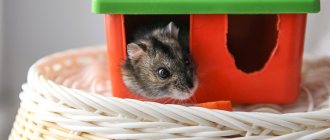Hamster aggression depending on breed
Djungarian hamsters can attack the owner during the adaptation period. An animal that is wild by nature has a negative attitude toward affection. However, over time, the hamster gets used to the presence of a person and is calm about being touched.
Another reason for aggressiveness may be the presence of several males in the same territory. The hamster can transfer competition and jealousy towards the female to similar individuals and to the owner. If you place animals in different cages, then attacks of aggression are also reduced .
Do Syrian hamsters bite or not? The rodent of this breed is more socialized and inclined to communicate. This peaceful and calm animal is easy to train and suitable as a pet for families with children. A pet can express a negative attitude by experiencing a strong feeling of fear. Clapping your hands and sudden movements of your hands can frighten the animal.
How to accustom a hamster to your hands?
The Campbell's hamster is a representative of the most biting breed . These wayward pets are more difficult to tame than other breeds. To facilitate adaptation, it is recommended to handle the rodent with gloves, otherwise there is a risk of being bitten. However, gradual taming will give results, and the animal will become a real pet. It's worth paying a little more attention to it.
Campbell's hamsters appreciate solitude. Cohabitation of several individuals is possible for a short period of time. Conflicts and fights can result in the death of the animal.
Features of handling Campbell's hamsters
Breeds of domestic hamsters are not as diverse as we used to think. Today it is common to breed the following breeds:
- Dzungarian (Sungur);
- Syrian hamsters;
- Angora hamster;
- Roborovsky's hamsters;
- Campbell's hamster.
Campbell's hamsters are one of the most problematic species to keep at home. For a comfortable stay for one hamster, it is enough to purchase a cage measuring 50 by 30 cm. Hamsters are unusually nimble, so the distance between the bars of the grid should not be more than 0.5 cm so that the pet does not escape. It is advisable to provide the animal with a running wheel. Under natural conditions, hamsters are excellent runners and sometimes cover considerable distances, so in a cage they need to receive sufficient physical activity.
Campbell's hamsters are nocturnal, which can be an obstacle to their communication with humans. They become active at night, and by morning they hide back in the house or nest. You can only communicate with them in the evening or early in the morning.
Incredible love of freedom is another characteristic feature of Campbell's hamsters. They don’t like to be picked up and begin to defend themselves and let their teeth in. Experienced owners often remove animals from cages while wearing gloves. However, once in your arms, these hamsters quickly come to their senses, becoming tame and affectionate.
Why do hamsters bite?
In nature, hamsters, recognizing new grains and greens, taste them. When faced with an unknown object, the animal instinctively pulls the object of study into its mouth. Studying and mastering new smells through a bite is a natural knowledge of the surrounding world . A bite can be caused by various reasons. Let's figure out why a hamster at home has become aggressive and bites.
In what cases can you give apples to hamsters?
Danger
A hamster that has not yet met its owner may bite or scream. The unknown smell of a person causes a feeling of danger in the furry animal. Gradual familiarization with the aroma of the skin will help establish contact. Getting used to the owner will go faster if you periodically bring your hand to the animal’s nose with smooth movements . And only after complete trust, you can take the rodent in your arms, placing your palm under the body.
Fear
When very frightened, hamsters are capable of emitting sharp and piercing screams. A plaintive squeak means helplessness and fear of death, and an intermittent squeal means an intention to defend itself.
Snorting, clicking teeth and trying to reach the object of irritation speaks of aggressive behavior and a desire to protect oneself in accessible ways. Any danger forces the hamster to hide in a shelter.
Smell of food
The animal perceives the residual smell of food as a new object for familiarization. The rodent does not react to the smell of clean, washed skin .
A change of scenery
The impetus for aggression comes from a change of environment. Moving to an unfamiliar environment, an abundance of new cage smells and excessive curiosity of household members put the little animal into a state of stress. After the animal has calmed down, explored the space and examined the toys, you can give a treat while stroking the fur.
How to choose a cage for a hamster?
Pain
Rough touching that causes pain. It is necessary to remember the fragile bone structure of the patient. Miniature internal organs and bones are easily damaged by careless movements.
Genetic memory
Living in the steppe, rodents were often attacked from the air. A hand raised from above can be considered an attack.
Showing affection
To show its owner its affection, the hamster rubs its head against its arms or neck. Sometimes, when carried away, a rodent can grab a small area of skin with its teeth, calling on the owner to participate in the game.
Grinding down teeth
The lack of mineral stones or dry branches in the cage forces the rodent to grind down its incisors on the first available hands. It is necessary to provide your pet with plant roots or a chalk stone.
Pregnancy
During pregnancy, it is advisable not to disturb the female hamster. Excessive importunity can cause an attack of aggression even in the most peaceful individual . The natural state of the female is indifference to games and decreased activity. It is recommended to pick it up for examination only in the first week of gestation. Before giving birth, it is better to inspect the rodent visually.
If a pet bites its owner, there is no need to swing or hit the animal. Loud swearing and aggressive intonations can frighten the rodent and delay the adaptation process for a long time.
Precautions after a bite and wound treatment
So, the Djungarian hamster bites - what to do? As a rule, bites from domestic rodents do not cause much harm to human health, but they can be quite painful. After all, hamsters’ incisors are very sharp and long, growing throughout their lives. Therefore, when bitten, a laceration usually forms, causing pain.
Having received such damage, immediately send the animal to the place and start treating the wound. To do this you need:
- urgently rinse the wound with water at room temperature using an antibacterial cleanser;
- disinfect with any antiseptic;
- cover the wound with a bactericidal plaster;
- if sharp painful sensations occur, take an antispasmodic.
If the temperature increases due to inflammation of the wound, see a doctor immediately.
Common Causes of Stress
Having set up its home, the rodent periodically checks its supplies and tries to hide them from prying eyes with a layer of sawdust or paper.
Accumulated supplies for a hamster are the key to stability, so moving the bins by the owner or throwing away food savings can lead to a serious shock for the animal. Having stuffed supplies into its cheek pouches, the animal will desperately rush around and look for a new secluded corner.
When cleaning the cage, it is advisable not to touch the provisions and throw away only those products that are harmful to health..
A hamster falls into a stressful state when there is a sudden change in the environment:
- Sudden change in diet.
- A bright flash of light while the animal is sleeping.
- Lack of water in the drinking bowl.
- Excessive care of the owner over newborn cubs.
Stress often occurs due to the close proximity of several individuals. When crowded and constantly interacting with other rodents, the hamster becomes irritated and loses its appetite. An excess of ammonia and carbon dioxide in the enclosure leads to paralysis of the respiratory tract and death. In this case, it is advisable to place the animals in separate dwellings. Natural ventilation and lack of crowding will calm the animal.
When should you wash your hamster in water?
How dangerous are animal bites?
How dangerous the bites of domestic hamsters are is a controversial question. Of course, if the pet has not had contact with other rodents, then it is unlikely to be a carrier of rabies. However, hamsters can be carriers of diseases common to humans, such as:
- tuberculosis;
- listerosis;
- toxoplasmosis;
- meningitis;
- salmonellosis.
Therefore, when a Djungarian hamster bites (or other breeds), if it is aggressive, agitated, or sleeps little, it is recommended to check the animal for infections.
Practice shows that there are very few cases of owners becoming infected with hamsters; it is still recommended to see a doctor if the bite becomes red, itchy or tingling. In other cases, simple treatment of the damaged area is sufficient.
How to stop your pet from “showing its teeth”?
In nature, hamsters have a strong sense of self-preservation. Pets have not lost this function. At the slightest change in background sound or smell, the animals become alert, sensing the source of danger . By standing on its hind legs and sniffing, the rodent determines the degree of anxiety. Having not detected a threat, the pet calms down.
To reduce the feeling of stress in your pet, you need to control the volume of your voice and not make sweeping movements. The animals distinguish the owner’s speech and sense intonation. Calm sounds with notes of affection are perceived by the pet with goodwill and a desire for contact.
In order not to provoke your ward into bites, you should listen to the recommendations of specialists:
- Do not interrupt your sleep with sudden sounds or movements.
- Before contact, call your pet in a quiet voice and give your hand for sniffing..
- Wash your hands thoroughly after eating without using strong smelling products.
- Use specialized toys to develop your hamster's skills.
Answering the question of how to wean a hamster from biting if its bites become regular, zoologists advise blowing lightly on your pet’s face and reducing the time of communication. By regularly applying this recommendation, you can instill in your hamster a prohibition against biting.
How to make toys for a hamster with your own hands?
What to do if you are bitten by a hamster until you bleed?
This question is most often asked by parents of small children who were bitten by a hamster until they bled. In such a situation, parents worry about whether it is possible to become infected with rabies from a pet. It is worth knowing that the chances of infection are extremely small, so all that needs to be done in such a situation is:
- Return the animal back to the cage.
- Stop the bleeding.
- Disinfect the wound and bandage the bitten area.
Under no circumstances should you scold your pet for such behavior. This is explained by the fact that hamsters have a very good memory, and if the owner allows himself to hit the animal at least once or simply offends it, it will remain an enemy for the rodent for the rest of its life.
Therefore, it is worth finding out why your pet behaved this way and not holding a grudge against him.
What provokes
Hamsters often start biting when they are handled. At the very beginning, they do not trust the new owners, and thus defend themselves. After purchasing, you should not pick it up or bring it particularly close to your face. Whatever the rodent is afraid of and does not use its teeth, it must be tamed.
Hamsters show aggression in several cases:
- The female is pregnant or with children. Thus, she wants to protect her family. Sees danger in a person.
- If you harm him. Often the child does not calculate his strength, and this causes harm to the animal. Children must understand that a pet is not a toy.
- A sudden change of scenery. The hamster gets comfortable and does not trust its owners. He needs time to get used to his new home and the people around him.
- There is no chalk or other dental device. You should definitely buy this accessory at a pet store.
- You should not hit a rodent, especially in his house. This is a fortress where he should feel protected.
- The pet may become restless and cause harm to its owners.
A common reason is the wrong location of his house. Do not leave in a draft. It is also worth monitoring the temperature in the apartment. The norm is 20-22 degrees. Hamsters are afraid of cold and heat.
It is advisable to quickly tame the hamster. You need to put your hand into the cage with his favorite treat. Pets often prefer fruits, vegetables and chicken. Food should be without salt and spices. There is no need to remove your hand, let the animal sniff it
After the meal, you need to show attention and pet the animal. Thus, he will begin to trust his owners. If after such manipulations your pet still bites, it is better to consult a veterinarian
The most popular breeds are the Dzhungarik and the Syrian hamster. They need to be tamed from childhood, since this will be difficult to do in adulthood. The friendliest of all the jungars. This breed is great for children
If after such manipulations your pet still bites, it is better to contact a veterinarian. The most popular breeds are the Dzhungarik and the Syrian hamster. They need to be tamed from childhood, since this will be difficult to do in adulthood. The friendliest of all the jungars. This breed is perfect for children.
The bites of these pets do not harm human health, but cause discomfort. If the animal does not want to eat, is in a good mood and has had a good night's sleep, it will not bite a person just like that.
These animals can bite when defending themselves from danger, when they mistrust the owner, or in case of improper handling. To avoid being bitten, the rodent must be tamed. The main reasons why hamsters bite may be the following:
- If the pet is female, she may bite when pregnant or with offspring. In such cases, bites are caused by the instinct of self-preservation and concern for the life of the cubs.
- If the rodent was hurt. Usually, small children, playing with a fluffy, can unintentionally squeeze it or crush it. The response will not be long in coming and the child will be bitten by the hamster.
- You should not pick up a Djungarian or other hamster immediately after purchasing. He needs to get used to the new environment, otherwise he will bite.
- The animal's teeth are not ground down. To do this, he needs to be given crackers or chalk specially designed for grinding teeth.
- If the pet was purchased for a child, first of all, adults should tell the rules of behavior with the animal, explain that it is not a toy and how to give yourself first aid for a bite if the hamster has bitten until it bleeds.
If for some reason an animal bites an adult or child, under no circumstances should he be beaten for this.
For the first few days after purchase, the rodent is in a stressful state, both from the new place of residence and from other people whom the animal does not yet trust. Therefore, you should not touch your pet.
The animal gnaws in the following situations:
- if the female is pregnant, in anticipation of the offspring the rodent is aggressive due to the instinct of self-preservation. The big threat comes from a female with hamsters;
- the animal feels pain when picked up incorrectly, this often happens when a pet falls into the hands of a child, when too much force is applied to the animal;
- A rodent will also bite when it gets into a new home, because it is embarrassed and stressed. It is recommended not to touch the pet; it will need to adapt to the new place;
- you need to prepare in advance so that the animal has a place to grind its teeth. These are crackers, special chalk. If you don’t provide your pet with what it needs, it will start gnawing on everything, including the owner’s hands;
- When buying an animal, children should understand that the animal is not a toy, it requires care and proper handling. It is also better to inform the child what needs to be done when bitten by a hamster, because children often panic and cry, frightened;
hamster bite
Common causes of bites
It is not easy to answer for sure why a hamster bites. Moreover, there can be many reasons for an animal’s aggressiveness. It can react to a threat from a person, to the smell of food from the hands and to improper handling. Sometimes a rodent simply shows affection in this way or even grinds down its incisors.
Hamster's reaction to threat
The main reasons why hamsters bite are:
- fear;
- protective instinct;
- female pregnancy.
Excessively loud noise near the cage, loud screams and rude attitude of children frighten and upset the hamster - especially if he has not yet fully become accustomed to the new environment. Therefore, when you bring your pet home, you should not take it out of its cage for at least 2-3 days to get used to people and the human voice. Another reason why the hamster began to bite is a protective instinct. By sticking a hand into a cage, a person is invading the animal's territory and posing a threat.
Female hamsters bite quite painfully during pregnancy. At this time, they are most susceptible to changes, and even an attempt to change water or food can result in a bite. If your hamster has become aggressive due to pregnancy, cleaning and changing food should be done as little as possible. And it is advisable to temporarily give up playing with him.
Smell of food
A hamster may bite a person whose hands smell of food, especially food that is unfamiliar to the pet. In this case, the owner himself may not feel the smell. However, the animal still painfully bites the finger, from which an unusual aroma emanates. Therefore, you should not pick up your hamster immediately after eating without washing your hands.
Mistreatment of animals
You should not ask whether hamsters bite if a person makes too sudden movements when trying to pick up the animal. Sharp gestures and, especially, screams make the hamster nervous and defensive.
You should not pick up a small rodent with your hands raised from above - otherwise the owners will immediately know whether their pets bite painfully. This gesture causes the hamster to instinctively fear and want to bite - due to the fact that in the wild they have enemies attacking from above.
It is also undesirable to touch animals by the head. It is best to wean the hamster from being scared by raising your hand to the side and letting it sniff your palm, which reduces the likelihood of a defensive reaction.
Showing affection from an animal
The Djungarian breed is one of the answers to the question of which hamsters do not bite - but even these cute animals may well change their usual behavior, wanting to play with the owner. Light biting of the hand, almost pinching, is not a symbol of aggression, but, on the contrary, a sign of a good mood. However, if during the game the pinching became more aggressive and the movements became nervous, this indicates that the hamster is tired and needs to pause and rest.
Hamster grinds down a tooth
Even a relatively calm and small dwarf sometimes bites painfully for one simple reason - it needs to grind down a tooth. For stitching, all objects within sight are used - from the bars of the cage to the hands of the owner. In order to wean a hamster from biting people, they put branches and bark of fruit trees in the cage, after dousing them with boiling water to disinfect them.
Causes of a pet's aggressive behavior
Aggression in pets is observed after purchasing a rodent or in an adult animal. Finding the reasons why hamsters bite is the primary task of the rodent owner. The animal's bites are dangerous: its fangs are carriers of bacteria and pathogenic microflora. For animals, teeth are a “tool” through which they understand the world. The little hamster explores the new territory and bites anyone who picks him up.
New hamsters bite to get information. Rodents are guided by three senses: hearing, smell and taste. There is nothing threatening in the aggressiveness of a new pet; if the animal has a calm disposition and begins to bite, the owner should consider the possible reasons for the change in the pet’s mood: in the external environment and in the pet’s well-being (the pet is sick). If the hamster did not bite and suddenly became aggressive, the reasons why the hamster bites, in most cases, lie in the behavior of the owner: the pet feels a constant threat.
Misbehavior of the owner
If a rodent bites occasionally, it doesn't like its environment. The rodent will not go to hands that smell bad. Rodents perceive foreign odors ten times more strongly. A pet bites when it smells food or new treats. Dzungarika tries to find out the source of the new smell and bites the owner. This behavior is not the pet's fault. You should wash your hands before handling furry pets.
How to pick it up for the first time
Don't plan to do this right away. Prepare the cage with food, water, sawdust. Rodents have poor vision. They use their nose to navigate their environment. So the new cage, the smells confuse them for a while. Simply place the box in which the animal was brought into the cage.
Open the lid, the hamster will come out when ready. Close the doors on the cage to prevent small children from grabbing the hamster. Do not keep the cage in your child's room.
The next day, use the end of the eraser on the pencil to gently touch the socket. Don't shake the cage.
Gently pet your hamster with an eraser until it gets used to being touched. Talk to him in a quiet voice. Do this several times throughout the day.
Relaxed, tame animals like to chew on small, hard objects - such as pencils - do not confuse this with biting. When the eraser ignores and doesn't cringe, it's time for the next step.
After a day or two, when the animal is not afraid of the pencil, place some treats on your open palm. A tiny piece of apple will do. Allow the rodent to stand up and sniff the hand and the apple. He can take an apple and go to the nest with it. Don't give a big piece, otherwise it won't come back.
Do this until you earn trust. You can stroke it with an eraser while your hand explores.
When he began to approach his hand without fear, it was time to take it. Slowly hug the hamster. Move one hand under your pet and the other above it. Keep your hands low in the cage so that if you fall, you won't fall far.
When the hamster relaxes in your hands, you can move on to the next step. Try to start in a room where there are no cracks to hide in so you can catch him if he runs away. Do this in a quiet place without distractions or other pets. When he tries to get out of one hand, offer him the other.
Find out more What to do if you are bitten or scratched by a monkey
A little more about the reasons
A hamster will never try to bite just like that; such a desire is always provoked by something. Below we will look at a number of factors that can significantly affect the behavior of the jungarik:
The female is pregnant
At such a delicate time, the female Djungarian hamster is especially susceptible to any changes.
Even a simple attempt to change water or food in the cage can make her nervous, and then she will begin to perceive a hand with a previously familiar smell as a hostile object that needs to be destroyed or driven away, which is why all cleaning and replenishment procedures must be carried out in advance.
You make sudden movements
The calmer the movements are when you pick up your pet, the less stress your hamster will experience on such a journey.
Any sharp gestures or a sudden rise in voice plunges the Dzungarian into shock, and he begins to defend himself, using his teeth.
You are picking up the hamster incorrectly
Khoma should not be taken with a hand raised from above, because at the level of instincts such a gesture causes enormous stress, since in the wild the Djungarians have enemies who attack from the air.
When making movements aimed at close contact, stand carefully, raising your hand to the side or sliding it under your khoma. Let him sniff your palm first, get to know the smell, and you will significantly reduce the chances of aggressive behavior.
No way to grind teeth
A hamster may indiscriminately try to grind its teeth on every object in sight.
To prevent this behavior, mineral stones and branches of fruit trees should always be present in the rodent's cage. Before giving the branches to be torn to pieces, they should be doused with boiling water in order to protect the homa from diseases and parasites.
Showing affection
Sometimes, by biting, the hamster shows its desire to play.
He carefully grabs and pinches the skin, but never bites until it bleeds.
If the homa's movements have become nervous and twitchy, and the biting is painful, this is a signal that the dzhungarik is tired or worried about something.
In such cases, it is necessary to pause, giving the rodent a rest.
First aid for hamster bites
Hamsters in their aggression can inflict very painful bites. This is due to their rather sharp and long teeth, which at the time of injury diverge to the sides and leave a painful mark in the form of a laceration.
- The bite site must be washed with warm soapy water. It is advisable to use laundry soap, since it, among all other types of soap, helps eliminate infections and bacteria.
- After washing the wound, it should be treated with a medical antiseptic. For this purpose, preparations such as a solution of ode, brilliant green, alcohol or hydrogen peroxide are excellent.
- Then, in order to prevent infectious agents from entering the bite wound, it is best to seal it with a bactericidal adhesive plaster. And if the bite occurs on a finger, it will be convenient to use a rubber fingertip while working around the house.
- If an intense painful syndrome develops, you can take a pharmacological agent with an analgesic effect.
We invite you to read: Why does a cat breathe with its mouth open, causes and solutions to the problem, video
Possible problems
You should stop your pet from biting from the first days after purchase. To begin with, the pet is petted, but not taken out of the cage. The pet slowly gets used to the smells and behavior of the household. The adaptation of the animal depends on the following factors:
- Breed. Djungarian hamsters are friendly, and Campbell's are rarely handled (a beautifully colored pet does not accept people).
- Floor. The behavior of the male depends on the time of year. The aggressiveness of the male is explained by the mating season of rodents.
- The character of the pet. Dzungarika is known for its playful character, while Syrian rodents are calm and quiet - this breed is best chosen for small children.
- "Neighbors." If one rodent from a pair begins to bite, the animals will have to be relocated for a while.
- The attitude of household members towards the animal. You must not touch the animal from the back or shout at it. It is impossible to wean a frightened animal from a bad habit. If a hamster bites, you cannot punish or beat the rodent.
The animal needs to adapt to new conditions and get used to a change in environment. Carefully rearrange the cage with the new pet.
Anyone can stop any breed of hamster from biting at home. Hamsters do not bite if the owner takes care of them.
Do Djungarian hamsters bite?
Biting means he is afraid
Fear and fear are most often the reason for such aggressive behavior in a hamster. He needs time to get comfortable and get used to it, so it is recommended not to disturb him for the first week. Give him time to adapt. Do not try to immediately clean the cage or change the bedding - the animal settles into its territory and marks it. Leave everything as it is for a while - this is in the best interests of the pet. Near the cage, behave calmly, without sudden movements that could frighten him. Do not pester him with tenderness - he is not yet ready to appreciate them, and most likely it will end in a bite.











